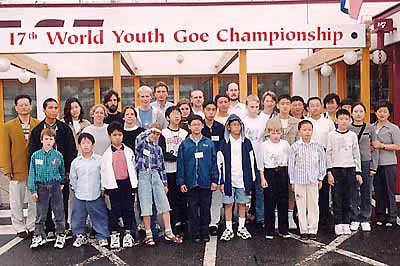 |
|
| Ing Cup World Youth Goe Tournament | |
 |
|
| Ing Cup World Youth Goe Tournament | |
 |
|
I wonder if my readers have heard of the Ing Cup World Youth Goe Tournament. In Europe it attracts a lot of attention, as it's the only tournament that brings together strong children from the East Asian go powerhouses and America and Europe. This year it's in its 17th year and was being held for the first time in Prague, the capital of the Czech Republic. I also attended it for the first time this year and set out from Milan full of anticipation. As the name indicates, the tournament is sponsored by the Ing Foundation. This year Korea, China, Japan, Taiwan and Singapore participated from Asia; with the children from Europe, the USA, Canada and the host country of Czech, that made a total of 20 boys and girls. They competed for one week for the honour of becoming the world's number one youth player. First, let's describe the tournament system. There are two sections, under-12 and under-18 (under-16 for children from countries with professional systems), with five games being played in each. The top four place-getters then play a knockout to decide the winner. The komi is 8 points, dame points are counted, and you need exactly 180 stones to play: these are the somewhat unusual Ing rules I've described before. Mr. Ing was thoroughgoing -- he even changed the name of the game from "go" to "goe"! |
|
 |
|
| Well, which country won, do you think?
The finals of each section were an exact
reflection of the contemporary international
go scene: they pitted Korean players against
Chinese, and each ended with a victory by
the Korean player. In the under-18 section, the Chinese player was a 13-year-old professional shodan (only players 6-dan and up are recognized as proper professionals in China), the Korean player was a 14-year-old from the top insei class who is on the point of making professional. That shows you how strong they are, and the game itself was impressive. The games leading up to the final had been mismatches; you can understand that the players from America and Europe would be weaker, but actually the players from Japan and Taiwan were just as outclassed. Witnessing this was quite discouraging. |
|
| To be honest, however, it was obvious from
the start what the result would be. The reason
is that the selection criteria in Japan are
different. The enthusiasm for this tournament
and awareness of it are different. The other countries are fielding their top players. In Japan the school term had not yet ended, for one thing, and for another, the insei tournament to become professional had begun. That made it difficult to find a representative; in the end, they found an insei who was free. Surely, however, it would be only good manners to select as the Japanese representative the strongest player. Go has now transcended the national level -- the world is its stage. I query the attitude of the inseis and the Nihon Ki-in that becoming a professional shodan is the most important thing. The inseis should be fired with the ambition to take a top place in a world championship. Don't they appreciate the significance of representing their country? The Korean team leader said: "There's no merit, as far as go is concerned, for the top Korean players. Next year we should send a second-level or third-level player; that would be better for everyone, as it would give another country a chance to win." In fact, the Korean player had important games waiting for him, so he couldn't stay to attend the prize-giving ceremony. If he's that busy, playing in the tournament must have placed quite a burden on him, so you can understand the team leader's point of view. In a competitive game, it can't be helped if one side is weaker. But what should be done about a difference in international awareness? I think it's a serious problem. I couldn't help feeling that I was beginning to understand why Japan can't win on the international stage. |
|
 |
 |